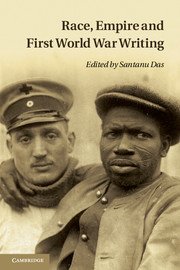Book contents
- Frontmatter
- Contents
- List of illustrations
- Acknowledgements
- Notes on contributors
- Introduction
- PART I VOICES AND EXPERIENCES
- PART II PERCEPTIONS AND PROXIMITIES
- 6 Representing Otherness: African, Indian and European soldiers' letters and memoirs
- 7 Living apart together: Belgian civilians and non-white troops and workers in wartime Flanders
- 8 Nursing the Other: the representation of colonial troops in French and British First World War nursing memoirs
- 9 Imperial captivities: colonial prisoners of war in Germany and the Ottoman empire, 1914–1918
- 10 Images of Te Hokowhitu A Tu in the First World War
- PART III NATIONALISM, MEMORY AND LITERATURE
- Index
- References
10 - Images of Te Hokowhitu A Tu in the First World War
Published online by Cambridge University Press: 05 February 2014
- Frontmatter
- Contents
- List of illustrations
- Acknowledgements
- Notes on contributors
- Introduction
- PART I VOICES AND EXPERIENCES
- PART II PERCEPTIONS AND PROXIMITIES
- 6 Representing Otherness: African, Indian and European soldiers' letters and memoirs
- 7 Living apart together: Belgian civilians and non-white troops and workers in wartime Flanders
- 8 Nursing the Other: the representation of colonial troops in French and British First World War nursing memoirs
- 9 Imperial captivities: colonial prisoners of war in Germany and the Ottoman empire, 1914–1918
- 10 Images of Te Hokowhitu A Tu in the First World War
- PART III NATIONALISM, MEMORY AND LITERATURE
- Index
- References
Summary
Te Hokowhitu A Tu – the Maori Contingent to the First World War and its successor contingents and reinforcements that became the Pioneer Battalion and then in September 1917 the New Zealand (Maori) Pioneer Battalion – was the public face of Maori military contribution in the First World War. A total of 2,227 Maori and 485 Pacific Islanders served in the Maori Contingent and its subsequent incarnations; 336 died on active service and 734 were wounded. This number was drawn from a male Maori population that was estimated to number no more than 30,000 in the 1911 census. An unknown number of Maori also served in the ranks of the provincial units of the New Zealand Expeditionary Force (NZEF), enlisting with their Pakeha (white New Zealander) mates from their home town and district. Although New Zealand introduced conscription in November 1916, the Pioneer Battalion remained a volunteer unit for Maori throughout the war. Government attempts to coerce the Waikato and Taranaki tribes, who mindful of the land confiscations of the New Zealand Wars of the 1860s refused to support the war effort, by introducing selective conscription for those tribes were unsuccessful. Yet the scale of the Maori war effort that managed to sustain a 1,000-strong unit for much of the war from such a limited population base has never really been appreciated by New Zealand, nor has its story been widely told.
- Type
- Chapter
- Information
- Race, Empire and First World War Writing , pp. 194 - 210Publisher: Cambridge University PressPrint publication year: 2011

